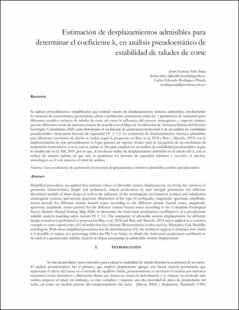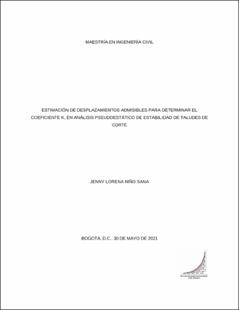Mostrar el registro sencillo del ítem
Estimación de desplazamiento admisibles para determinar el coeficiente K, en análisis pseudoestático de estabilidad de taludes de corte
| dc.contributor.advisor | Rodriguez Pineda, Carlos Eduardo | |
| dc.contributor.author | Niño Sana, Jenny Lorena | |
| dc.date.accessioned | 2021-08-05T17:43:55Z | |
| dc.date.accessioned | 2021-10-01T15:36:23Z | |
| dc.date.available | 2021-08-05T17:43:55Z | |
| dc.date.available | 2021-10-01T15:36:23Z | |
| dc.date.issued | 2021 | |
| dc.identifier.uri | https://repositorio.escuelaing.edu.co/handle/001/1652 | |
| dc.description.abstract | Se aplican procedimientos simplificados que estiman valores de desplazamientos sísmicos admisibles, involucrando la variación de características geométricas, altura e inclinación, aceleración crítica ky y parámetros de resistencia para diferentes modelos teóricos de taludes de corte así como la influencia del entorno sismogénico y espectro sísmico para las diferentes zonas de amenaza sísmica de acuerdo con el Mapa de Zonificación de Amenaza Sísmica del Servicio Geológico Colombiano 2020, para determinar el coeficiente de aceleración horizontal k de un análisis de estabilidad pseudoestático alcanzando factores de seguridad FS ≥ 1,0. La estimación de desplazamientos sísmicos admisibles para diferentes escenarios de diseño se realiza según lo propuesto en Bray et al, 2018 y Bray y Macedo, 2019; con la implementación de este procedimiento se logra generar un soporte técnico para la escogencia de un coeficiente de aceleración horizontal k, con el cual se reduce el Am para emplear en un análisis de estabilidad pseudoestático según lo establecido en la AIS, 2010 ,por lo que, al involucrar índice de desplazamiento admisible en el cálculo del k, este se reduce de manera óptima tal que aún se garantizan los factores de seguridad mínimos y envuelve el entorno sismológico en él está inmerso el talud de análisis. | spa |
| dc.description.abstract | It is important to know, for the analysis site, which is the seismogenic source that contributes the greatest seismic hazard to the total exceedance probability curve identified for each return period. For those areas that do not have seismic microzonation studies, this information can be found in the Seismic Hazard Study for Colombia 2009; given that the same site of interest within the radius of coverage of the analysis may be affected by different seismogenic sources, but it is the one that contributes most to the seismic hazard that dominates the analysis of seismic displacements generated by earthquakes associated with different seismogenic sources. The estimated range of expected seismic displacement for a slope are not precise estimates since to be accurate additional knowledge is required by performing advanced analyses, however, by having an idea of the expected range the proposed procedure is useful and can also provide reasonable estimates for cases where advanced analyses are not justified. It is emphasized that the values obtained as allowable seismic displacements should be taken as indices of the slope behavior after the occurrence of an earthquake generated by different seismogenic sources. Therefore, for the implementation of the procedures for both the estimation of displacements and the horizontal acceleration coefficient, the analysis criteria, the premises exposed throughout the document and the limitations that are intrinsically in each formulation must be taken into account. However, it is specified that the results obtained should not be generalized, neither for the same geometric characteristics, shear strength or seismological environment, since each slope is independent and the values of displacement and horizontal acceleration coefficient are intrinsically linked to the specific and local conditions of the slope under study. In order to validate the procedures used in this analytical thesis, but in the context of the seismological and geological environment of Colombia, monitoring and instrumentation plans should be implemented in both natural and shear slopes in order to know which would be the admissible seismic displacements generated by each seismogenic source. | eng |
| dc.format.extent | 10 páginas | spa |
| dc.format.mimetype | application/pdf | spa |
| dc.language.iso | spa | spa |
| dc.rights | Derechos reservados-Escuela Colombiana de Ingeniería Julio Garavito, 2021 | spa |
| dc.title | Estimación de desplazamiento admisibles para determinar el coeficiente K, en análisis pseudoestático de estabilidad de taludes de corte | spa |
| dc.type | Trabajo de grado - Maestría | spa |
| dc.type.version | info:eu-repo/semantics/publishedVersion | spa |
| oaire.accessrights | http://purl.org/coar/access_right/c_abf2 | spa |
| oaire.version | http://purl.org/coar/version/c_970fb48d4fbd8a85 | spa |
| dc.contributor.referee | EDGAR BARBOSA, MANUEL GARCÍA | |
| dc.description.degreelevel | Maestría | spa |
| dc.description.degreename | Magíster en Ingeniería Civil | spa |
| dc.identifier.ark | https://catalogo.escuelaing.edu.co/cgi-bin/koha/opac-detail.pl?biblionumber=22717 | |
| dc.publisher.program | Maestría en Ingeniería Civil | spa |
| dc.relation.indexed | N/A | spa |
| dc.relation.references | AIS (Asociación Colombiana de Ingeniería Sísmica) Código colombiano de diseño sísmico de puente (2014) Bogotá D.C. AIS (Asociación Colombiana de Ingeniería Sísmica) Norma colombiano de diseño sismo resistente (2010) Bogotá D.C. Ambraseys, N,N,, Menu, J,M,, 1988, Earthquake-induced ground displacements, Earthquake Engineering and Structural Dynamics 16, 985–1006. Arcila, M, García, J,, Montejo, J,, Eraso, J,, Valcarcel, J,, Mora, M,,Viganò, D, Pagani, M, y Díaz, F, (2020), Modelo nacional de amenaza sísmica para Colombia, Bogotá: Servicio Geológico Colombiano y Fundación Global Earthquake Model. Bray, J,D,, Travasarou, T, 2007, Simplified procedure for estimating earthquake-induced deviatoric slope displacements, Journal of Geotechnical and Geoenvironmental Engineering 133, 381–392. Bray, J,D,, Travasarou, T, 2009, Pseudostatic coefficient for use in simplified seismic slope stability evaluation, Journal of Geotechnical and Geoenvironmental Engineering 135, 1336–1340. Bray, J, D, and J, Macedo, 2019, “Simplified seismic slope stability excel spreadsheets,” Accessed July 18, 2019. Bray, J, D, J, Macedo, and T, Travasarou, 2018, “Simplified procedure for estimating seismic slope displacements for subduction zone earthquakes,” J, Geotech, Geoenv, Eng, 144 (3): 04017124. Jibson, R,W,, 1993, Predicting earthquake-induced landslide displacements using Newmark's sliding block analysis, Transportation Research Record 1411, 9–17. Jibson, R, W, and D, K, Keefer, Analysis of the Seismic Origin of Landslides: Examples from the New Madrid Seismic Zone, Geological Society of America Bulletin, Vol, 105, No, 4, 1993, pp, 521-536. Jibson, R,W, Jibson, M,W,, 2003, Java programs for using Newmark's method and simplified decoupled analysis to model slope performance during earthquakes, U,S, Geological Survey Open-File Report 03-005, version 1,1. Jibson, R,W, 2007, Regression models for estimating seismic landslide displacement, Engineering Geology 91, 209–218. Jibson, R.W., 2011. Methods for assessing the stability of slopes during earthquakes—A retrospective. US Geological Survey, Box 25046, MS 966, Denver Federal Center, Denver, CO 80225, USA Report 112 (2011) 43-50. Keefer, D, K,, and R, C, Wilson, Predicting Earthquake-Induced Landslides, With Emphasis on Arid and Semi-Arid Environments, In Landslides in a Semi-Arid Environment, Inland Geological Society, Riverside, Calif,, Vol, 2, 1989, pp, 118-149. Kramer, S, L, 1996, Geotechnical Earthquake Engineering, Prentice Hall, Upper Saddle River, NJ, 653 pp. Kramer S, L, and M, W, Smith, “Modified Newmark Model for Seismic Displacements of Compliant Slopes,” Journal of Geotechnical and Geoenvironmental Engineering, Vol, 123, No, 7, 1997, pp, 635-644. Newmark, N, M, Effects of Earthquakes on Dams and Embankments, Geotechnique, Vol, 15, No, 2, 1965, pp, 139-159. Oteo Mazo C. y Rodríguez Ortiz J. M, Curso aplicado de Cimentaciones 4ta Edición, 1989 Rathje, E,M,, Bray, J,D,, 1999, An examination of simplified earthquake-induced displacement procedures for earth structures, Canadian Geotechnical Journal 36, 72–87. Seismosoft, Earthquake Engineering software solutions, 2020. Shahgholi, M, A, Fakher, C,J, Jones, 2001, Horizontal slice method of analysis, Géotechnique, 51, 881-885. Slide (2D). (2018). Rocscience. Rocscience Stewart, J, P, Blake, T, F,, and Hollingsworth, R, A, _2003_, “A screen analysis procedure for seismic slope stability,” Earthquake Spectra, 19_3_, 697–712. Sarma, S,K, D, Tan, 2006, Determination of critical slip surface in slope analysis, Géotechnique, 56, 539-550. Wieczorek, G, F, R, C, Wilson, and E, L, Harp, Map Showing Slope Stability During Earthquakes in San Mateo County, California, Miscellaneous Investigations Map 1-1257-E, U,S, Geological Survey, 1985. Wilson, R, C,, and D, K, Keefer, Dynamic Analysis of a Slope Failure from the 6 August 1979 Coyote Lake, California, Earthquake, Bulletin of the Seismological Society of America, Vol, 73, No, 3, 1983, pp, 863-877. | spa |
| dc.rights.accessrights | info:eu-repo/semantics/openAccess | spa |
| dc.subject.armarc | Taludes de corte | |
| dc.subject.armarc | Sismometría - Sismología | |
| dc.subject.armarc | Geotecnia | |
| dc.subject.proposal | Coeficiente de aceleración horizontal | spa |
| dc.subject.proposal | Desplazamientos sísmicos admisibles | spa |
| dc.subject.proposal | Análisis pseudoestático | spa |
| dc.subject.proposal | Horizontal acceleration coefficient | eng |
| dc.subject.proposal | Allowable seismic displacements | eng |
| dc.subject.proposal | Pseudo-static analysis | eng |
| dc.type.coar | http://purl.org/coar/resource_type/c_bdcc | spa |
| dc.type.content | Text | spa |
| dc.type.driver | info:eu-repo/semantics/masterThesis | spa |
| dc.type.redcol | https://purl.org/redcol/resource_type/TM | spa |
Ficheros en el ítem
Este ítem aparece en la(s) siguiente(s) colección(ones)
-
CF - Trabajos de Grado Maestría en Ingeniería Civil [421]
Trabajos de Grado de la Maestría en Ingeniería Civil de la Escuela Colombiana de Ingeniería Julio Garavito












